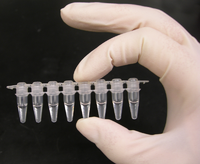
Photo from wikipedia
Exponential amplification reaction (EXPAR), as a simple and high sensitive method, holds great promise in nucleic acids detection. One major challenge in EXPAR is the generation of trigger DNA with… Click to show full abstract
Exponential amplification reaction (EXPAR), as a simple and high sensitive method, holds great promise in nucleic acids detection. One major challenge in EXPAR is the generation of trigger DNA with a definite 3'-end, which now relies on fingerprinting technology. However, the requirement of different endonucleases for varying target sequences and two head-to-head recognition sites in double stranded DNA, as well as the confinement of trigger DNA's 3'-end to be near/within the recognition site, usually subject EXPAR to compromised universality and/or repeated matching of reaction conditions. Herein, we report a simple and universal method for high sensitive detection of nucleic acids, termed aligner-mediated cleavage-triggered exponential amplification (AMCEA). The aligner-mediated cleavage (AMC) needs only one nicking endonuclease and can make a break at any site of choice in a programmable way. Thus, the 3'-end of target DNA can be easily redefined as required, a key step for initiating the amplification reaction. This capability endows the proposed AMCEA with excellent universality and simplicity. Moreover, it is sensitive and specific, with a detection limit at amol level, a broad dynamic range of 5~6 orders of magnitude and the ability to distinguish single nucleotide mutation. Experiments performed with human serum indicate that AMCEA is compatible with the complex biological sample, and thus has the potentials for practical applications.
Journal Title: Talanta
Year Published: 2018
Link to full text (if available)
Share on Social Media: Sign Up to like & get
recommendations!